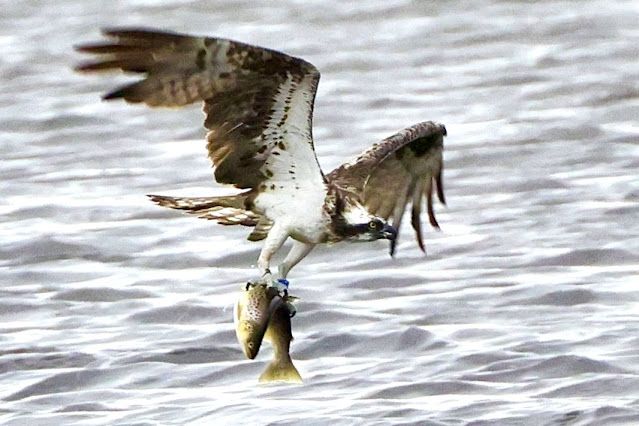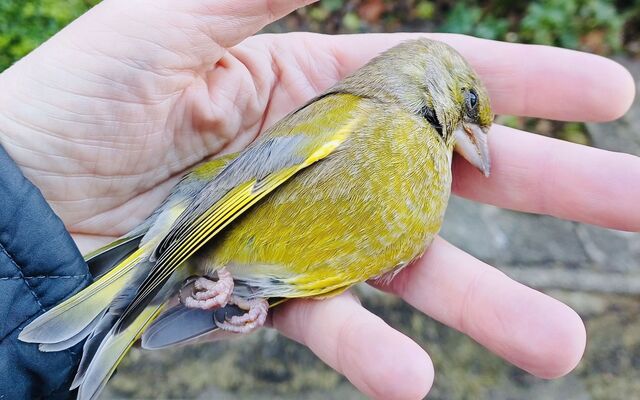THIS bird could save Lough Neagh. It’s an osprey – iascaire coirneach in Irish – photographed by birdwatcher Michael Latham as it plucked a fish from the River Bann this week.
This incredible species was exterminated along with half of our 12 birds of prey by people – in the osprey’s case, it was probably seen as a rival for fish, but its eggs were also stolen by collectors and it was shot to be stuffed and put on display in museums and houses of the gentry.
That a pair of them were fishing on the Bann Estuary this week near Portstewart is clear sign that they still like this place.
Ospreys breed on lakes, leaving sea eagles to take fish from the coastal waves. And there can be no better lake in the whole of Ireland than the biggest of them all, the 151 square miles of Lough Neagh.
The osprey could be the symbol of Lough’s renewal and the restoration of its ecosystem.
Imagine how truly fantastic it would be if we could travel to its shores and watch this magical bird swooping down to catch fish in its talons. There wouldn’t be a school in the land who wouldn’t want to take their pupils to see such a spectacle.
They used to breed there, of course, just like they did in lakes the length and breadth of the country. A drawing of one with a fish in its talons appears in the ninth century Book of Armagh and its Irish name – which means tonsured fisherman – dates from a time when monks ‘tonsured’ their hair to leave a bald patch on their scalp as a sign of devotion to God (it was only abandoned by Papal order in 1972).
So what does the osprey need to help it return to Lough Neagh? Well, fish for starters, and then a tall tree on the riverside on which to build a nest. Is that too much to ask for?
Apparently it is.
With Lough Neagh being choked by blue-green algae, we’re a long way from having a healthy habitat that can host ospreys.
Ospreys are thought to have become extinct as a breeding bird in Ireland in the late 18th century due to systematic persecution, and while they have often been spotted in NI on migration to & from sub-Saharan Africa, confirmed breeding in Ireland has been elusive until now. pic.twitter.com/ioNYMBRbht
— Ulster Wildlife (@UlsterWildlife) August 24, 2023
But why not make the return of the osprey a priority? Because if it returns, we know that the ecosystem has been restored.
It means the water is healthy, fish are plentiful and also that this stunning bird can safely nest on the shore.
Last year the first breeding ospreys in more than 200 years nested in Fermanagh and raised three chicks. The nest site remains a secret, not because it’s believed the birds will be put in any danger, but for now they don’t want them to be surrounded by birdwatchers. But once they get settled, they can become a tourist attraction, as they are at some Scottish lakes. There are now 300 breeding pairs in Scotland, an amazing statistic that illustrates just how depleted Ireland’s natural environment is.
The truth is that today, the massive Lough Neagh probably doesn’t even have enough fish to sustain a single pair of ospreys – that’s why they were hunting this week closer to Portstewart. In centuries past, the fish stock of our lakes and indeed sea was many multiples of what they are today.
The osprey pictured here on the Bann has a salmon in its talons – a fish that was plentiful in Irish rivers until we started netting them almost to extinction. At this very spot on the Bann in 1632, 62 tons of salmon – 10,000 fish – were netted in a single day. Only for the fact that it was recorded, we would never believe that such an abundance of salmon was even possible.
One incredible thing about the osprey – at least to Dúlra – is that it’s migratory. He’s more used to thinking that only our small birds migrate – warblers and swallows – but ospreys travel 3,500 miles every year to Africa and back.
The adult birds head off first, leaving their fledglings to fend for themselves and find their own way to Africa! It’s a perilous journey and only 40 per cent of them make it. In total, ospreys just spend five months here.
So if Dúlra had the power, he’d make the osprey the symbol of the new, healthy Lough Neagh that we all aspire to.
This majestic bird won’t return to the Lough when there’s algae, continual farm pollution and industrial sand dredging of the Lough bed. It needs a healthy Lough. Build that, and they will come.
• If you’ve seen or photographed anything interesting, you can text Dúlra on 07801 414804.







